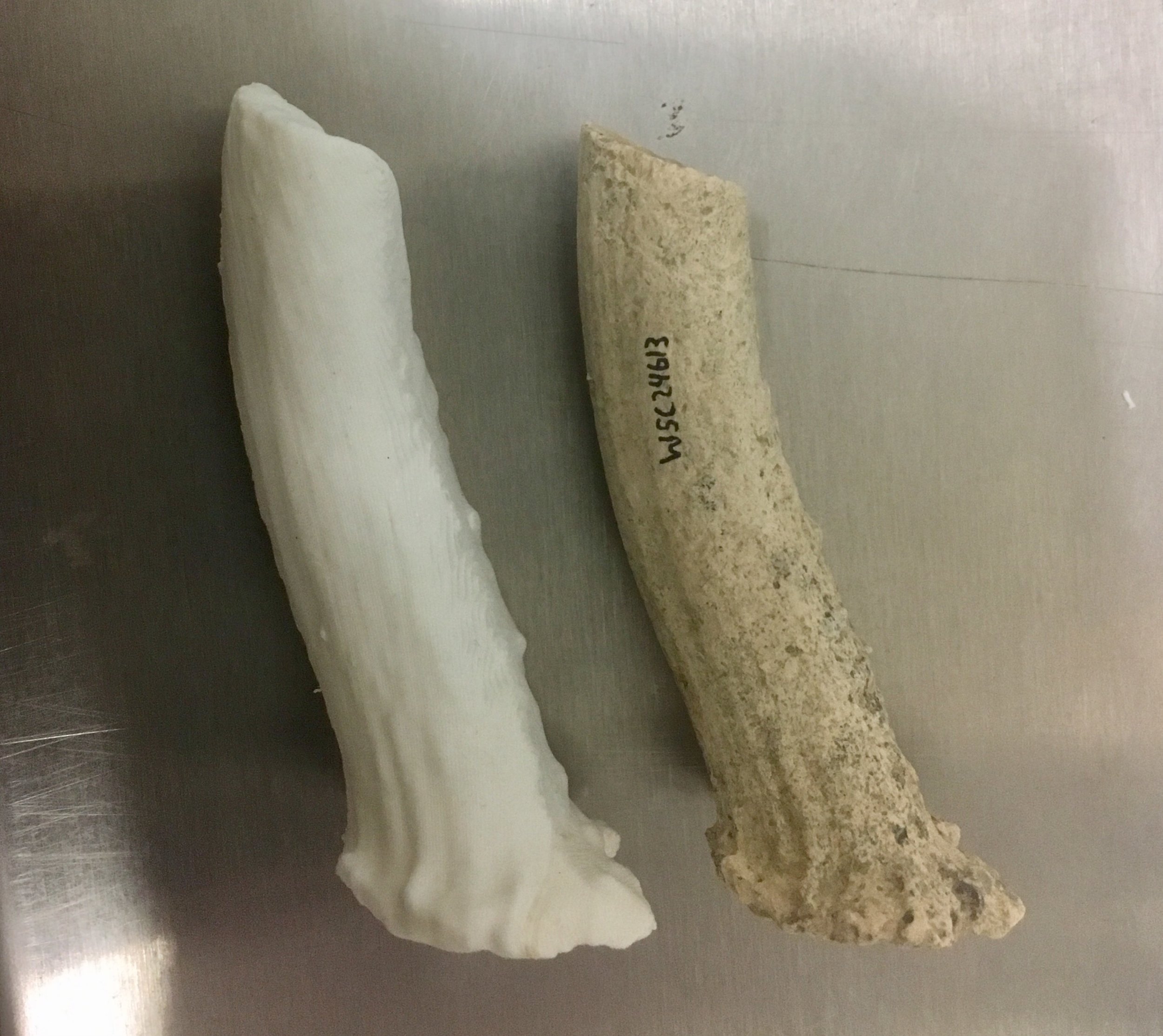 Over the last few weeks we’ve been continuing both our studies of the collection of Pleistocene fossils from the Harveston neighborhood of Murrieta, as well as setting up and learning to use our new 3D scanning and printing capabilities. These two projects have rapidly started to come together. The specimen on the right is an antler from a small deer, consistent in size and shape with the white-tailed deer Odocoileus virginianus (that’s been the case with all our deer material from Harveston so far). Given the way this antler is preserved, it’s likely that it was a shed antler.On the left is a 3D print of the same antler. We’ve now printed out several fossils at WSC, but what makes this one unique is that it’s the first print based on a 3D image file that we produced in-house. Rather than being produced with a laser scanner, this file was generated using photogrammetry, using 70 different photos of the antler. We’re planning to use both laser scanning and photogrammetry to generate our 3D models.The model of the deer antler is available for viewing or download on Sketchfab.
Over the last few weeks we’ve been continuing both our studies of the collection of Pleistocene fossils from the Harveston neighborhood of Murrieta, as well as setting up and learning to use our new 3D scanning and printing capabilities. These two projects have rapidly started to come together. The specimen on the right is an antler from a small deer, consistent in size and shape with the white-tailed deer Odocoileus virginianus (that’s been the case with all our deer material from Harveston so far). Given the way this antler is preserved, it’s likely that it was a shed antler.On the left is a 3D print of the same antler. We’ve now printed out several fossils at WSC, but what makes this one unique is that it’s the first print based on a 3D image file that we produced in-house. Rather than being produced with a laser scanner, this file was generated using photogrammetry, using 70 different photos of the antler. We’re planning to use both laser scanning and photogrammetry to generate our 3D models.The model of the deer antler is available for viewing or download on Sketchfab.
Fossil Friday - deer humerus
 One of the collections at WSC comes from the Harveston neighborhood of Murrieta in Riverside County. While this is a fairly small collection, it’s amazingly diverse, with well over a dozen different species of mammals. A group of us have started going through this collection to document it. One of the Harveston specimens is a small deer, probably the genus Odocoileus. The element above is the distal end of the humerus. Modern Odocoileus includes the mule deer O. hemionius and the smaller white-tailed deer O. virginianus. Interestingly, the Harveston specimen is quite a bit smaller than modern white-tailed deer, even though it’s an adult. We have a few other deer elements from the Harveston material that we’ll have to compare to see if the size difference is consistent.
One of the collections at WSC comes from the Harveston neighborhood of Murrieta in Riverside County. While this is a fairly small collection, it’s amazingly diverse, with well over a dozen different species of mammals. A group of us have started going through this collection to document it. One of the Harveston specimens is a small deer, probably the genus Odocoileus. The element above is the distal end of the humerus. Modern Odocoileus includes the mule deer O. hemionius and the smaller white-tailed deer O. virginianus. Interestingly, the Harveston specimen is quite a bit smaller than modern white-tailed deer, even though it’s an adult. We have a few other deer elements from the Harveston material that we’ll have to compare to see if the size difference is consistent.
Fossil Friday - deer forelimb
 Almost all the species alive today were also around during the Ice Age. While they may have been filling different niches in the much more diverse Pleistocene fauna, their remains are very recognizable. WSC has a small collection of fossils from Murrieta that include remains from a number of extant species. Among these are two associated forelimb bones from a deer, the humerus (above) and the radius (below, both in anterior view)
Almost all the species alive today were also around during the Ice Age. While they may have been filling different niches in the much more diverse Pleistocene fauna, their remains are very recognizable. WSC has a small collection of fossils from Murrieta that include remains from a number of extant species. Among these are two associated forelimb bones from a deer, the humerus (above) and the radius (below, both in anterior view) Below are the same two bones in posterior view:
Below are the same two bones in posterior view:
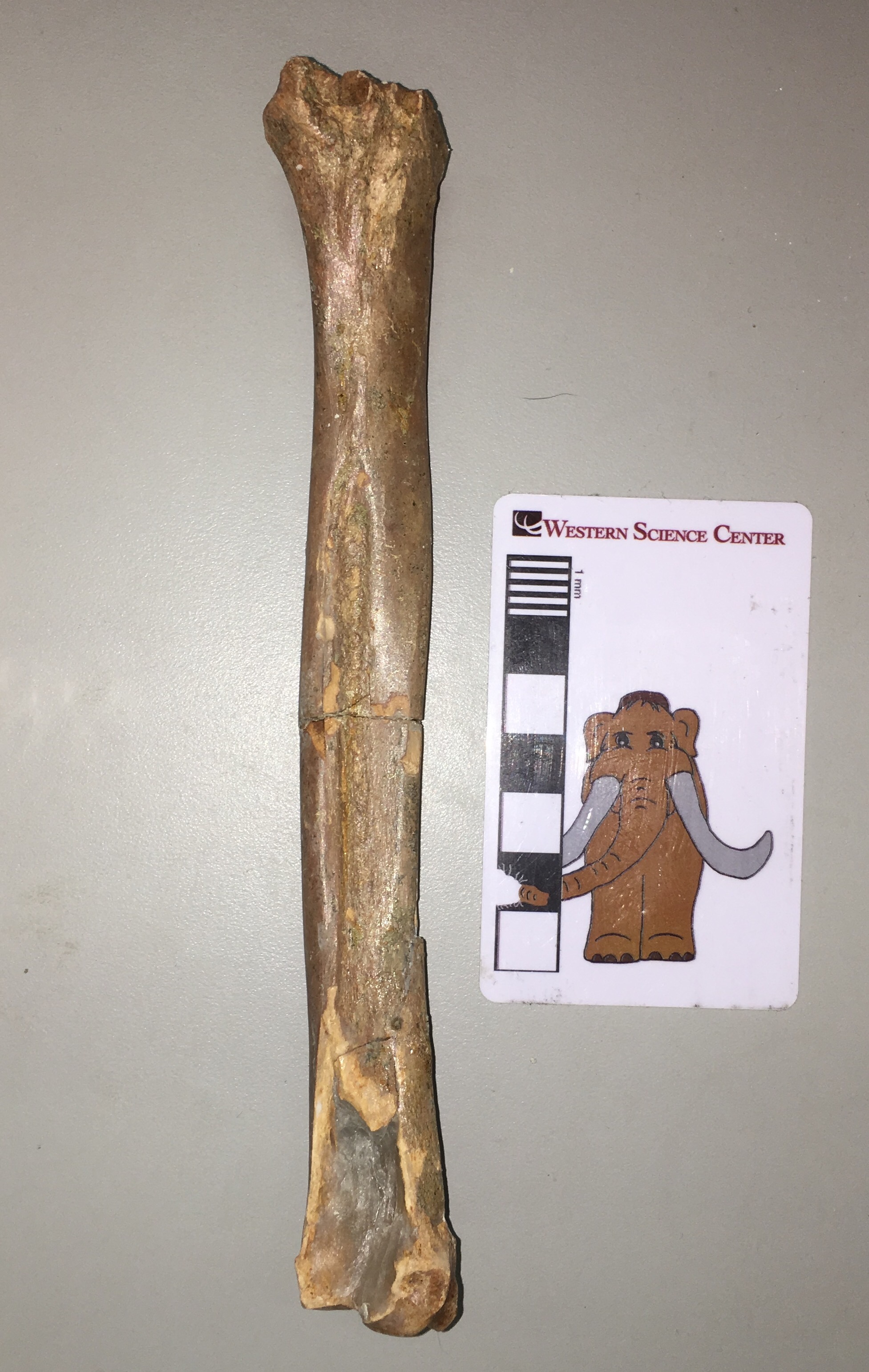 The humerus is missing the proximal 1/3 or so, but is otherwise in good shape. The radius is nearly complete except for a fragment at the distal end. While it's difficult to see in these photos, there is some evidence of gnaw marks from rodents at the distal end of the humerus.Both of these bones are from the left forelimb, and they articulate quite nicely (lateral view, with anterior to the left):
The humerus is missing the proximal 1/3 or so, but is otherwise in good shape. The radius is nearly complete except for a fragment at the distal end. While it's difficult to see in these photos, there is some evidence of gnaw marks from rodents at the distal end of the humerus.Both of these bones are from the left forelimb, and they articulate quite nicely (lateral view, with anterior to the left): These bones are pretty much a perfect match for Odocoileus, the genus that includes the white-tailed deer and the mule deer. They are surprisingly small, however, and are a good bit smaller than the female white-tailed deer I was using as a reference. I'm not sure if this has any significance, since it's difficult to draw generalized conclusions from a single specimen.
These bones are pretty much a perfect match for Odocoileus, the genus that includes the white-tailed deer and the mule deer. They are surprisingly small, however, and are a good bit smaller than the female white-tailed deer I was using as a reference. I'm not sure if this has any significance, since it's difficult to draw generalized conclusions from a single specimen.
Taphonomy everywhere
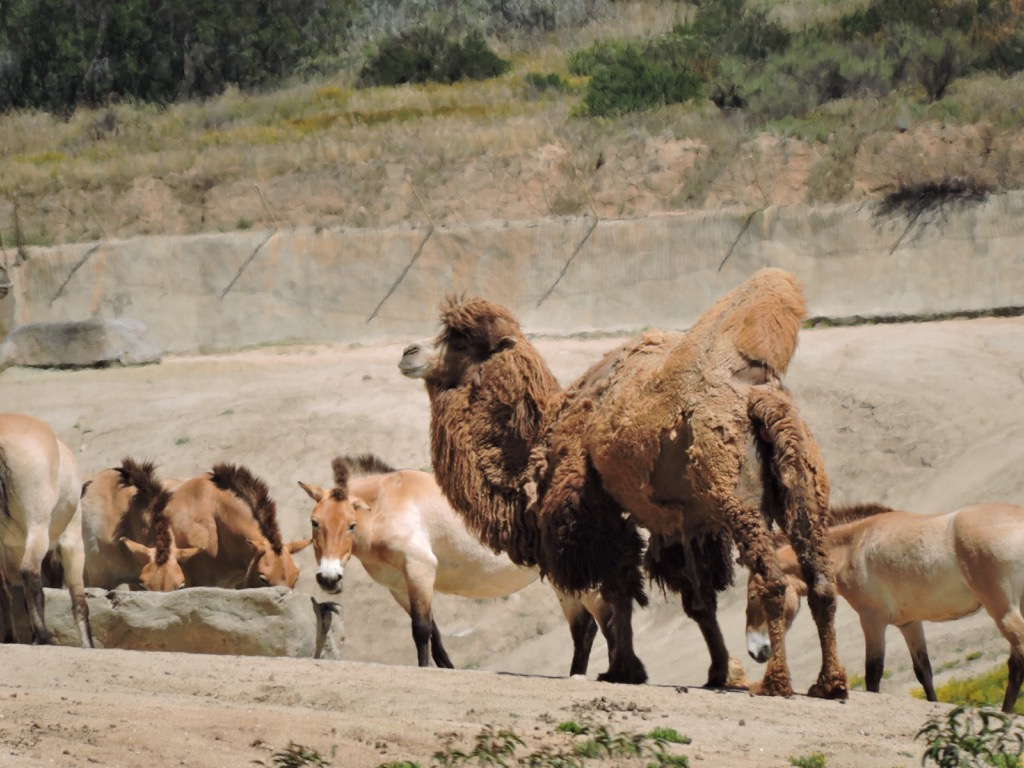 A big part of understanding paleontology is to understand the way things work today. In interpreting fossils, paleontologists first look to the modern world for analogs, whether it's identifying a species, interpreting behavior and ecological relationships, or even understanding how a fossil came to be preserved at all – the subbranch of paleontology known as taphonomy.A few weeks ago Brett and I were visiting the San Diego Zoo's Safari Park, located in Escondido about 45 minutes from the museum. While photographing Przewalski's horses and Bactrian camels (above, both of which have Pleistocene relatives preserved at Diamond Valley Lake), Brett noticed an odd shape located on a hillside in the exhibit (inside the red circle below):
A big part of understanding paleontology is to understand the way things work today. In interpreting fossils, paleontologists first look to the modern world for analogs, whether it's identifying a species, interpreting behavior and ecological relationships, or even understanding how a fossil came to be preserved at all – the subbranch of paleontology known as taphonomy.A few weeks ago Brett and I were visiting the San Diego Zoo's Safari Park, located in Escondido about 45 minutes from the museum. While photographing Przewalski's horses and Bactrian camels (above, both of which have Pleistocene relatives preserved at Diamond Valley Lake), Brett noticed an odd shape located on a hillside in the exhibit (inside the red circle below):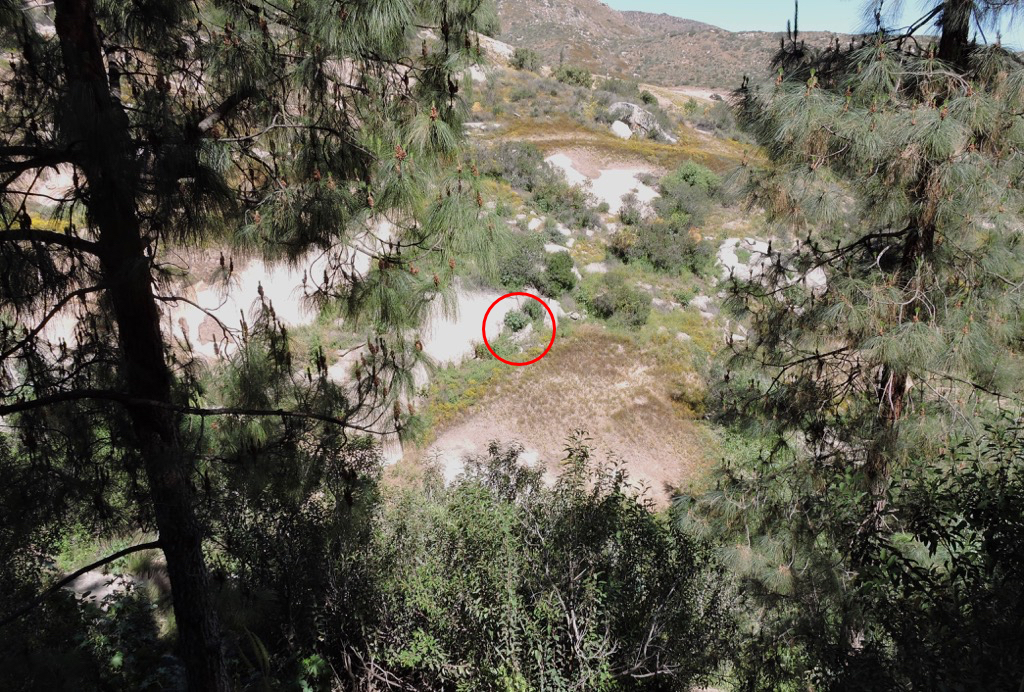 Fortunately I have a camera with a pretty powerful zoom lens, so I was able to get a closeup look at the area:
Fortunately I have a camera with a pretty powerful zoom lens, so I was able to get a closeup look at the area: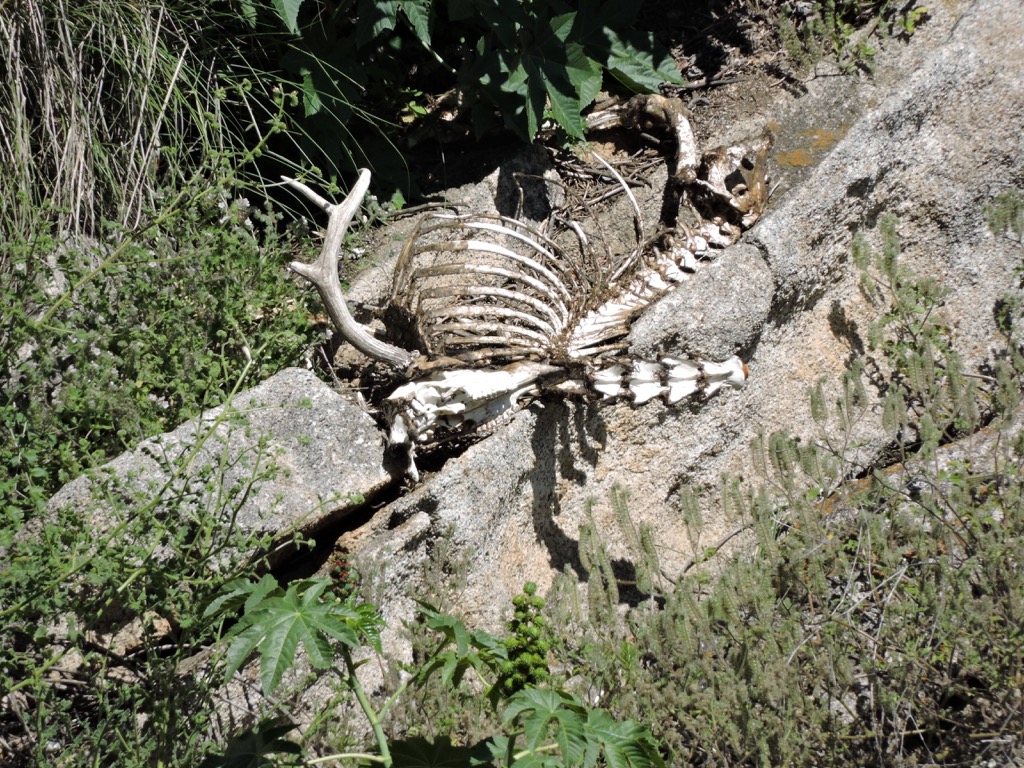 A skeleton! There's enough here to make an attempt at some identifications:
A skeleton! There's enough here to make an attempt at some identifications: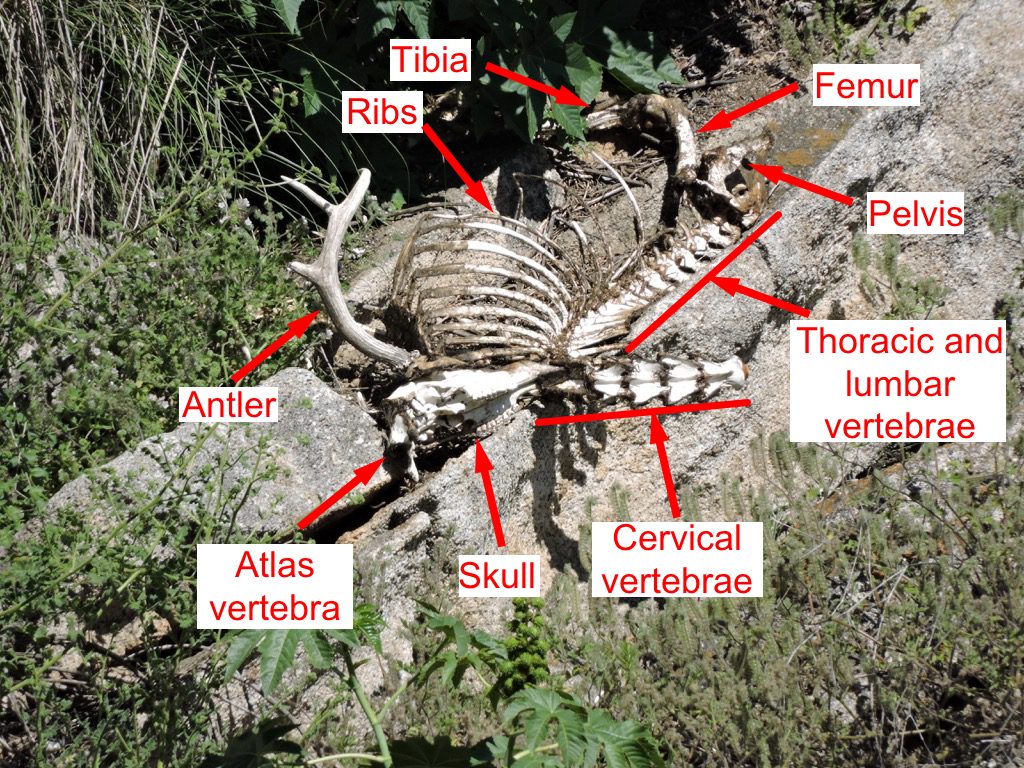 Quite a lot of this skeleton is present, and we can say a fair amount about it. First, the presence of an antler is significant. We can tell it's an antler and not a horn from the multiple tines (at least three), and because it has a growth pedicle. That puts this in the Cervidae, the deer family. Unless it's an exotic animal from the zoo collection or some other source (unlikely) that means a mule deer, Odocoileus hemionus.The skeleton is mostly intact and articulated, and there are still a few bits and pieces of skin and fur attached in places. The neck has bent backwards, a common occurrence after death. As the carcass dries out, the nuchal ligament that runs along the back of the neck tends to shorten, pulling the head backwards over the back.There has been some disturbance to the skeleton. The head has been pulled off the body. With the attached atlas vertebra, it has been flipped upside down (relative to the body) and rotated 180 degrees so that the snout is facing the back. The lower jaw is missing entirely. The lower parts of the hind limbs are probably obscured by vegetation, but the front limbs including the shoulder blades are missing. With the skeleton sitting on a steep hillside, we wondered if some the bones had ended up downhill, and we spent a half hour or so with the camera examining the hillside, with some success. About 10-20 m down the hill we located an ulna:
Quite a lot of this skeleton is present, and we can say a fair amount about it. First, the presence of an antler is significant. We can tell it's an antler and not a horn from the multiple tines (at least three), and because it has a growth pedicle. That puts this in the Cervidae, the deer family. Unless it's an exotic animal from the zoo collection or some other source (unlikely) that means a mule deer, Odocoileus hemionus.The skeleton is mostly intact and articulated, and there are still a few bits and pieces of skin and fur attached in places. The neck has bent backwards, a common occurrence after death. As the carcass dries out, the nuchal ligament that runs along the back of the neck tends to shorten, pulling the head backwards over the back.There has been some disturbance to the skeleton. The head has been pulled off the body. With the attached atlas vertebra, it has been flipped upside down (relative to the body) and rotated 180 degrees so that the snout is facing the back. The lower jaw is missing entirely. The lower parts of the hind limbs are probably obscured by vegetation, but the front limbs including the shoulder blades are missing. With the skeleton sitting on a steep hillside, we wondered if some the bones had ended up downhill, and we spent a half hour or so with the camera examining the hillside, with some success. About 10-20 m down the hill we located an ulna: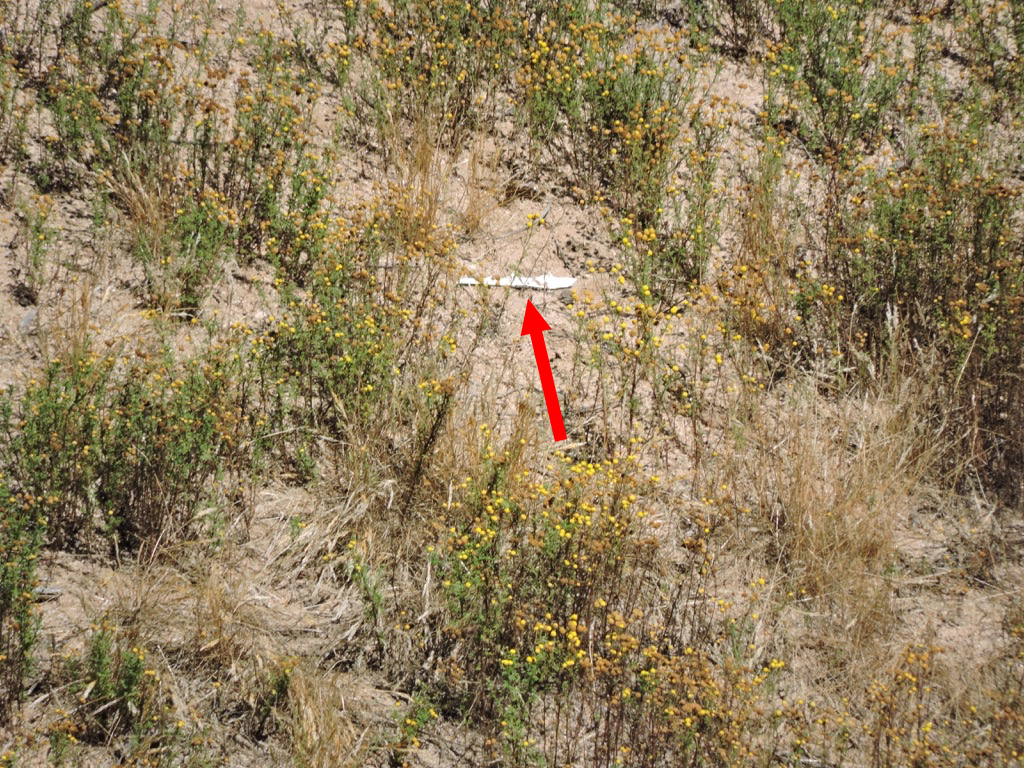 ... a partial scapula:
... a partial scapula: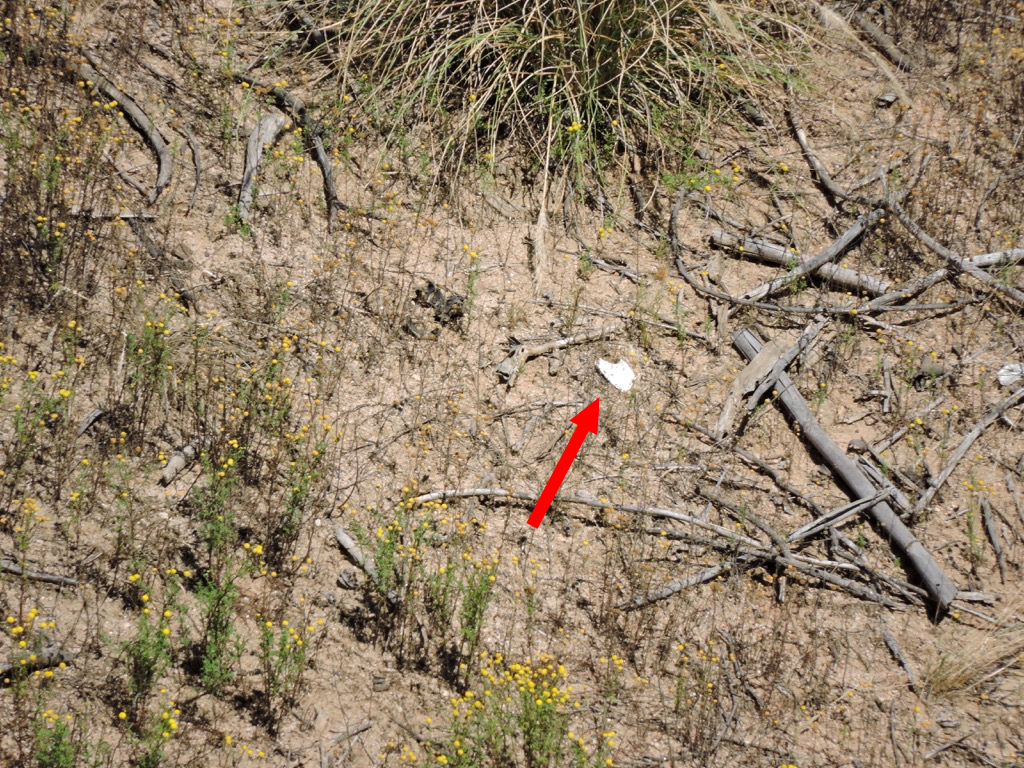 ...and a humerus:
...and a humerus: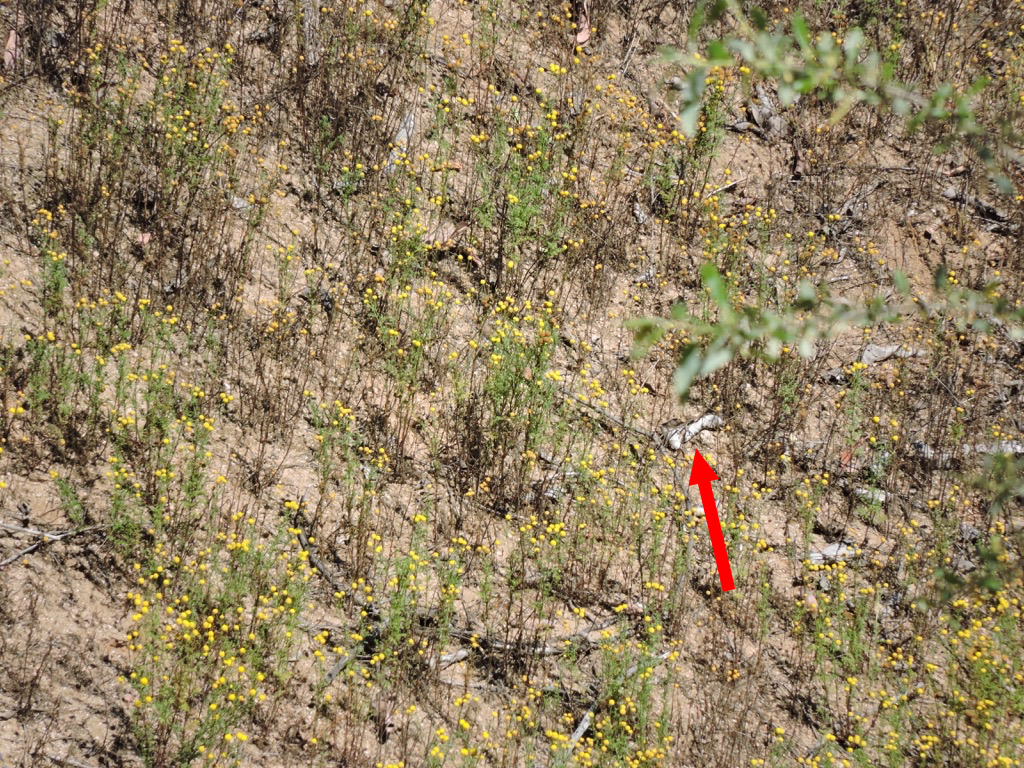 We never did find the lower jaw.So, what's the story of this skeleton? I'm not sure why the deer was in the enclosure in the first place, but there are steep cliffs in the area; I suppose it's possible the deer could have fallen in, and maybe even been killed in the fall. There was some disturbance of the carcass after death, but probably not by really large scavengers. I assume zoo staff would have removed the carcass or left it alone entirely, so they probably aren't responsible for the disturbance. I also think it's unlikely that large carnivorans such as coyotes, black bears, and mountain lions are allowed to roam freely with the zoo's herbivores, and they likely would have torn up the skeleton more than what we see. Small carnivores are a different matter. On the same trip we saw squirrels passing back and forth through small openings in some of the fences; a feral cat could have passed through the same openings. For that matter, squirrels and other rodents will also scavenge carcasses, mostly looking for calcium in the bones. But the most likely culprits are scavenging birds such as ravens, crows, and turkey vultures. These birds are large enough to strip a carcass and even remove some pieces (like the skull and the front legs), but often leave large parts of the skeleton intact, and, of course, they have no difficulty in gaining access to the enclosure.Since this skeleton is in a zoo, it's somewhat protected from the full range of taphonomic processes it would be exposed to in the wild, such as large mammalian scavengers, but that alone isn't enough to save it. Over time, the skeleton will break down in the sun. The outer cortical bone will deteriorate and flake away, and once the interior bone is exposed the breakdown will occur even faster. Occasional rainstorms will speed this process, as will insects and rodents feeding on the bone itself. More robust fragments, such as the ends of limb bones and flakes of tooth enamel may survive a bit longer and wash down the hill. There is a small stream at the bottom of the hill, so it's conceivable (if unlikely) that a few of these more robust fragments could be buried in stream sediments. Within a few years, if anything of this deer survives, that will probably be all there is.
We never did find the lower jaw.So, what's the story of this skeleton? I'm not sure why the deer was in the enclosure in the first place, but there are steep cliffs in the area; I suppose it's possible the deer could have fallen in, and maybe even been killed in the fall. There was some disturbance of the carcass after death, but probably not by really large scavengers. I assume zoo staff would have removed the carcass or left it alone entirely, so they probably aren't responsible for the disturbance. I also think it's unlikely that large carnivorans such as coyotes, black bears, and mountain lions are allowed to roam freely with the zoo's herbivores, and they likely would have torn up the skeleton more than what we see. Small carnivores are a different matter. On the same trip we saw squirrels passing back and forth through small openings in some of the fences; a feral cat could have passed through the same openings. For that matter, squirrels and other rodents will also scavenge carcasses, mostly looking for calcium in the bones. But the most likely culprits are scavenging birds such as ravens, crows, and turkey vultures. These birds are large enough to strip a carcass and even remove some pieces (like the skull and the front legs), but often leave large parts of the skeleton intact, and, of course, they have no difficulty in gaining access to the enclosure.Since this skeleton is in a zoo, it's somewhat protected from the full range of taphonomic processes it would be exposed to in the wild, such as large mammalian scavengers, but that alone isn't enough to save it. Over time, the skeleton will break down in the sun. The outer cortical bone will deteriorate and flake away, and once the interior bone is exposed the breakdown will occur even faster. Occasional rainstorms will speed this process, as will insects and rodents feeding on the bone itself. More robust fragments, such as the ends of limb bones and flakes of tooth enamel may survive a bit longer and wash down the hill. There is a small stream at the bottom of the hill, so it's conceivable (if unlikely) that a few of these more robust fragments could be buried in stream sediments. Within a few years, if anything of this deer survives, that will probably be all there is.
Fossil Friday - deer antler
 With Fossil Friday falling on Christmas, I would have liked to post a picture of a fossil reindeer (Rangifer tarandus). But most of the vertebrate fossils at Western Science Center are from Riverside County, and while reindeer (or caribou, as they're called in North America) did make it as far south as Georgia during the Ice Age they apparently never made it to southern California. So instead I've gone with the closest relative to reindeer in our collection.Rangifer is a member of the family Cervidae, the deer. A unique and highly visible feature of cervids is the presence of antlers in males in almost all extant species (a few species don't grow antlers, and in reindeer the females also grow them).Shown above is the base of an antler from the Early Pleistocene deposits in San Timoteo Canyon, found during the Southern California Edison El Casco Substation project. This is the left antler seen in lateral view, with anterior to the left. The bone at the base is a fragment of the frontal, which makes up part of the braincase. The cylindrical shaft angling back from the frontal is called the pedicle, while the rugose portion at the tip is the coronet. Here's a medial view of the same fragment:
With Fossil Friday falling on Christmas, I would have liked to post a picture of a fossil reindeer (Rangifer tarandus). But most of the vertebrate fossils at Western Science Center are from Riverside County, and while reindeer (or caribou, as they're called in North America) did make it as far south as Georgia during the Ice Age they apparently never made it to southern California. So instead I've gone with the closest relative to reindeer in our collection.Rangifer is a member of the family Cervidae, the deer. A unique and highly visible feature of cervids is the presence of antlers in males in almost all extant species (a few species don't grow antlers, and in reindeer the females also grow them).Shown above is the base of an antler from the Early Pleistocene deposits in San Timoteo Canyon, found during the Southern California Edison El Casco Substation project. This is the left antler seen in lateral view, with anterior to the left. The bone at the base is a fragment of the frontal, which makes up part of the braincase. The cylindrical shaft angling back from the frontal is called the pedicle, while the rugose portion at the tip is the coronet. Here's a medial view of the same fragment: Antlers are unique in that, even though they are made of bone, they are shed and regrown periodically, usually every year. The pedicle is the only permanent part of the antler. In contrast, other mammals with comparable head gear, such as bovids (cattle and antelopes), have horns that consist of a bony core covered with a keratin sheath and that are never shed (pronghorns shed the keratin sheath but not the bony core).(As an aside, antler growth is initiated by hormones stimulating specialized connective tissue that covers the pedicle. In researching this blog post, I was surprised to find that injuries to the skin in other parts of the head can result in antler growth at the sites of the injuries, so that occasionally a deer will grow extra antlers (Bubenik and Hundertmark 2002)!)When I first looked at this specimen, I was struck by its size; it's much larger than the white-tailed deer (Odocoileus virginianus) I frequently saw back east. I briefly wondered if it might be from an elk (Cervus elaphus), another species that, like reindeer, apparently never made it to southern California. We happen to have a modern elk in the WSC collection, and a quick comparison showed that, large as it is, our fossil specimen is much smaller than a mature elk:
Antlers are unique in that, even though they are made of bone, they are shed and regrown periodically, usually every year. The pedicle is the only permanent part of the antler. In contrast, other mammals with comparable head gear, such as bovids (cattle and antelopes), have horns that consist of a bony core covered with a keratin sheath and that are never shed (pronghorns shed the keratin sheath but not the bony core).(As an aside, antler growth is initiated by hormones stimulating specialized connective tissue that covers the pedicle. In researching this blog post, I was surprised to find that injuries to the skin in other parts of the head can result in antler growth at the sites of the injuries, so that occasionally a deer will grow extra antlers (Bubenik and Hundertmark 2002)!)When I first looked at this specimen, I was struck by its size; it's much larger than the white-tailed deer (Odocoileus virginianus) I frequently saw back east. I briefly wondered if it might be from an elk (Cervus elaphus), another species that, like reindeer, apparently never made it to southern California. We happen to have a modern elk in the WSC collection, and a quick comparison showed that, large as it is, our fossil specimen is much smaller than a mature elk: This specimen is probably close to the upper end of the size range for a mule deer, Odocoileus hemionus, which does live in southern California. There may also be extinct species of Odocoileus from the Early Pleistocene that are possibilities, but with only an antler fragment it may not be possible to make a definite identification of this specimen beyond the family or genus. Reference: Bubenik, G. A. and Hundertmark, K. J., 2002. Accessory antlers in male Cervidae. Zeitschrift für Jagdwissenschaft 48:10-21.
This specimen is probably close to the upper end of the size range for a mule deer, Odocoileus hemionus, which does live in southern California. There may also be extinct species of Odocoileus from the Early Pleistocene that are possibilities, but with only an antler fragment it may not be possible to make a definite identification of this specimen beyond the family or genus. Reference: Bubenik, G. A. and Hundertmark, K. J., 2002. Accessory antlers in male Cervidae. Zeitschrift für Jagdwissenschaft 48:10-21.
Fossil Friday - deer metacarpal
 One point I often come back to is how the Pleistocene fauna is in many ways so similar to today's fauna. Geologically speaking, the Ice Age is the recent past; many of the species alive then are still with us today.The bone shown above is the right metacarpal (forefoot bone) of a deer from the genus Odocoileus. Odocoileus is the most common large wild mammal in North America today, with the white-tailed deer O. virginianus found through most of the continent and into South America, and the mule deer O. hemionus ranging throughout western North America. While mule deer tend to be a bit larger than white-tailed deer (at least today), it's difficult if not impossible to distinguish between them based on limited remains such as this.This metacarpal is incomplete, with the proximal portion (closest to the wrist) broken off. The image above is in anterior view, while below is the posterior view:
One point I often come back to is how the Pleistocene fauna is in many ways so similar to today's fauna. Geologically speaking, the Ice Age is the recent past; many of the species alive then are still with us today.The bone shown above is the right metacarpal (forefoot bone) of a deer from the genus Odocoileus. Odocoileus is the most common large wild mammal in North America today, with the white-tailed deer O. virginianus found through most of the continent and into South America, and the mule deer O. hemionus ranging throughout western North America. While mule deer tend to be a bit larger than white-tailed deer (at least today), it's difficult if not impossible to distinguish between them based on limited remains such as this.This metacarpal is incomplete, with the proximal portion (closest to the wrist) broken off. The image above is in anterior view, while below is the posterior view: At the distal end of the bone, note that there are two articulations. Deer are members of the Family Cervidae, which are in the Order Artiodactyla. Like their relatives the Bovidae (cattle and their kin), Camelidae (camels), and many other artiodactyl groups, deer have two digits on each foot, digits III and IV (the middle and ring fingers on the hand, and the equivalent toes on the foot).Deer were not a major component of the fossil fauna at Diamond Valley Lake; horses, bison, camels and even mastodons are more common as fossils in these deposits. Nevertheless, they were common enough for multiple specimens to show up in the sample.
At the distal end of the bone, note that there are two articulations. Deer are members of the Family Cervidae, which are in the Order Artiodactyla. Like their relatives the Bovidae (cattle and their kin), Camelidae (camels), and many other artiodactyl groups, deer have two digits on each foot, digits III and IV (the middle and ring fingers on the hand, and the equivalent toes on the foot).Deer were not a major component of the fossil fauna at Diamond Valley Lake; horses, bison, camels and even mastodons are more common as fossils in these deposits. Nevertheless, they were common enough for multiple specimens to show up in the sample.

